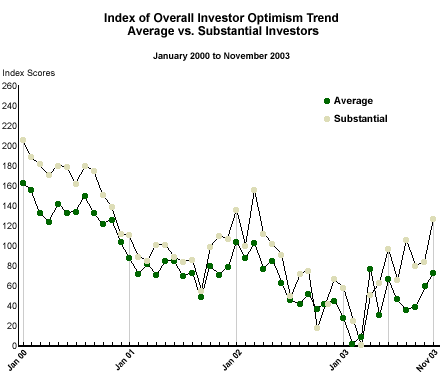According to the UBS/Gallup Index of Investor Optimism*, the level of optimism among substantial investors -- those with $100,000 or more of investable assets -- surged upward in November. While the Index also moved up among average investors (those with less than $100,000 of investable assets), the increase was much more muted.
Part of this gap in perceptions is attributable to differing outlooks toward the unemployment situation. Average investors are not too optimistic about jobs -- just as many of these investors said they are pessimistic about unemployment (41%) as said they are optimistic (40%). On the other hand, substantial investors are more likely to say they're optimistic (49%) about the unemployment situation than pessimistic (33%).
Given the Bureau of Labor Statistics (BLS) announcement last Friday that the U.S. economy added only 57,000 jobs in November, one might wonder whether average investors have a better read on current conditions in the job market than their more wealthy counterparts. Will substantial investors lose some of their enthusiasm in light of the jobs report? In turn, will investor optimism lessen as the year comes to a close?
Substantial Investor Optimism Surges
The Index of Investor Optimism increased 43 points among substantial investors, from 84 in October to 127 in November -- higher than the substantial investor Index was a year ago and not much below where it was in November 2000. In sharp contrast, among average investors, the Index of Investor Optimism increased only 13 points to 73 in November -- less than twice its level of a year ago and far below its November 2000 level.

Average Investors See a Different Recovery
Three years ago, majorities of both substantial and average investors held similarly optimistic -- if mistaken -- views of the economy and the investment climate. Last year at this time, both groups held virtually identical pessimistic views. According to the most recent survey, however, the two groups differ sharply -- the gap between the substantial and average investors equals 54 points.
Why is there currently such a large gap in investor perceptions? Much of the answer lies in the unusual nature of the recovery. Substantial investors tend to see the recovery in terms of economic growth, productivity, and corporate profits. As most economists note, those trends are improving rapidly, and the jobs situation will have little or no impact on them.
Average investors, on the other hand, tend to see the recovery in terms of jobs and wages. Prior to the significant revisions in the employment data announced in October, there seemed to be a growing consensus that we were experiencing a "jobless recovery." After the October revisions took place, many observers asserted that new job growth was actually surging within the economy. Following the latest BLS release, there is renewed uncertainty. And given all the changes taking place in the BLS data, we'll probably see more revisions and more uncertainty concerning jobs, punctuated by intense political positioning on both sides of the issue.
Regardless of the precise job numbers being reported by the BLS, structural changes are going to continue to impact job growth and wage rates in 2004. While the jobs report may keep a lot of average investors from jumping on the economic recovery bandwagon, the report is also likely to keep the Federal Reserve from increasing interest rates when it meets later today. In turn, continued low interest rates could make substantial investors even more optimistic about the U.S. economy's prospects in early 2004. As a result, chances are good that substantial and average investors will continue to have different views of the economic recovery as next year gets underway.
*Results for the Index of Investor Optimism -- U.S. are based on telephone interviews with a randomly selected U.S. sample of 801 adult investors, aged 18 and older, with at least $10,000 of investable assets, conducted Nov. 1-13, 2003. For results based on these samples, one can say with 95% confidence that the maximum error attributable to sampling and other random effects is ±4 percentage points. In addition to sampling error, question wording and practical difficulties in conducting surveys can introduce error or bias into the findings of public opinion polls.

